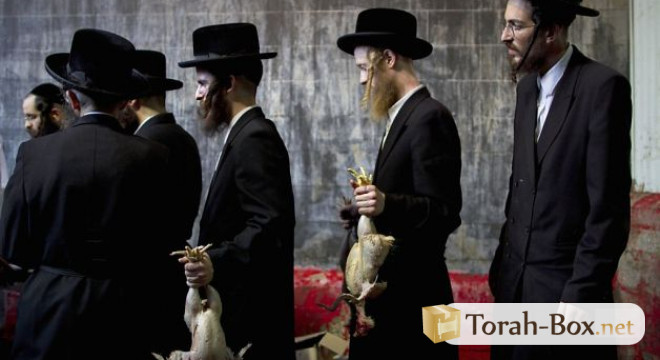
Yom Kippur
Halacha: The Custom of Kapparot
The custom of doing Kapparot is rooted in holy sources, and goes back to the time of the Geonim, about a thousand years ago. Nowadays, it is a widespread custom in many communities around the world. It involves taking a rooster for every man in the house and a chicken for every woman. For a pregnant woman, a rooster and two hens are used, because we do not know if she is carrying a boy or a girl. For a person with limited means, it is enough to take a cock for all the men and a hen for all the women of the house. This custom can be embellished by taking white cocks for men, by virtue of the verse [Yeshayahu 1.18]: "Oh! Come, let us reconcile, says the Lord! If your sins were blood-red, they could become white as snow ... "It is better for the head of the family to start himself by shaking the rooster around his head, and then above the other members of his family. As it says about a Kohen Gadol (High Priest): "He will make atonement for himself and for his house". Thus, he will acquire a merit for himself and may atone for others. [Shlah, Shavat Yair, Kaf Hachaim]
Thoughts of Repentance
We must think about doing Teshuvah at the time of Kapparot. In addition, we must have in mind that all that is done to the chicken is an example of the four deaths inflicted by the court, which should have been inflicted on us personally. Indeed, when the Shochet (ritual slaughterer) holds the neck of the chicken, this serves as strangulation. When he slays it, it corresponds to death by the sword. When he taps it on the ground, it is equivalent to stoning. Then when he plucks it and grills it, it corresponds to death by fire. By the fact that he identifies himself with the chicken and sincerely thinks of repenting, Hashem, whose right hand is outstretched, and is ready to receive the repentant, will forgive him.
Slaughter
A chicken must not be killed next to a live chicken, so as not to make it suffer. But also, because we fear that its sight will deteriorate because of the fear and that it will become forbidden fo consumption (taref). [Yore De'a 36.12]
Covering the Blood
After slaughtering the beast, the Shochet is obliged to cover, with earth, the blood which flowed at the beginning of the slaughtering process. Before slaughtering the chicken, soil must be placed on the ground and the slaughtering should be carried out over the chicken. Before covering up the blood, the shochet will say the blessing: "Baruch ah Hashem Elokeinu melech ha'olam asher kideshanu bemitsvotav vetsivanu al kissui hadam beafar".
The blood should only be covered with soil after checking the knife, and this commandment concerns the Shochet, for the Torah says, "He who has shed blood shall cover it''. Nevertheless, it is good that once the Shochet has covered the blood of the first chicken he slaughtered, he should leave the owner of the rest of the chickens, to do it himself [it is good that the shochet should appoint this person as his substitute]. It is a Mitzvah to seek to do this important act, especially nowadays, when it is not widespread. If several family members are present, everyone should bless their chicken and cover the floor. The same laws apply for women.
After the chicken has been slaughtered, it is necessary to salt the chicken, according to halacha, and to eat it. Then money for the redemption of the chicken must be given the needy. This is preferable to giving the chickens themselves to the poor, lest they be ashamed to receive a poultry on which our sins have been transferred.
Torah-Box.net Account
To access the entire Torah-Box.net website, sign up for free in less than a minute.
Weekly Parsha
 Candle Lighting - New York
Candle Lighting - New York
Friday May 3th, 2024 at 19:36 *Shabbat ends at 20:42 *
change my location
* Times given as an indication, check the times of your community






